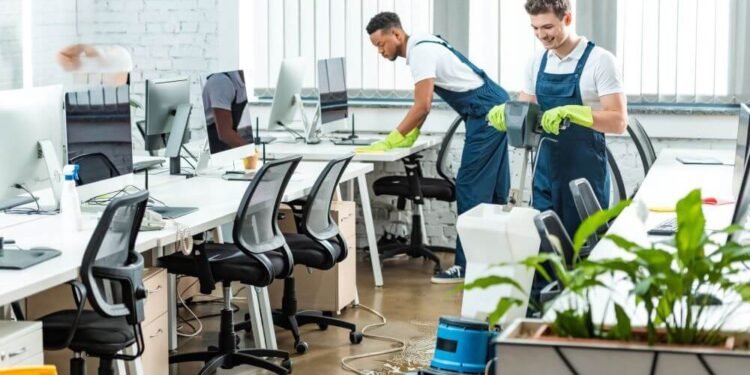Maintaining a clean and hygienic office environment is essential for employee health, productivity, and overall workplace satisfaction. Dust, germs, and clutter can contribute to illnesses, allergies, and decreased morale. Implementing effective cleaning strategies can ensure a healthier workspace year-round.
Read on to learn some office cleaning best practices to keep your team healthy year-round.
Hire Professional Cleaners for Consistent Results
While staff can handle basic tidying, professional cleaners can deliver hospital-level sanitation using industrial equipment like electrostatic sprayers and commercial-grade HEPA vacuums. Trained technicians follow CDC-recommended disinfection protocols, addressing often-missed areas such as ceiling vents, baseboards, and elevator buttons with medical-grade disinfectants.
If your facility is over 5,000 sq ft, specialized services can become critical, particularly in healthcare, food service, or shared workspaces where cross-contamination risks demand OSHA-compliant cleaning logs. Third-party providers can also assume liability for proper chemical handling and disposal.
Therefore, if your business in Fort Worth or similar locations needs professional assistance, you can rely on trusted providers offering Fort Worth cleaning services to maintain high standards.
Establish a Daily Cleaning Routine
A consistent daily cleaning routine is crucial for maintaining a hygienic office environment. By disinfecting high-touch surfaces like doorknobs, light switches, and keyboards, the spread of germs is minimized. Daily trash removal can also prevent unpleasant odors and deter pests, contributing to effective pest control practices, while sweeping or vacuuming office floors can reduce dust and allergens that can trigger respiratory issues. This structured approach can ensure a healthier workspace, boosting employee productivity and well-being. Regular upkeep can also prevent grime buildup, making deep cleaning more manageable.
Furthermore, a thorough office cleaning strategy requires attention to high-traffic and high-touch zones. Prioritizing these areas can ensure effective germ control and a healthier workspace. From workstations to restrooms, targeted cleaning can help minimize contamination risks, enhance air quality, and promote employee well-being.
Use the Right Cleaning Products
Selecting the right cleaning products is essential for both effectiveness and workplace safety. While generic cleaners may remove visible dirt, only EPA-registered disinfectants are proven to eliminate harmful pathogens like influenza and COVID-19. Harsh chemicals containing bleach or ammonia can aggravate asthma and allergies, making green alternatives preferable for daily use.
Also, microfiber technology can enhance cleaning performance by capturing microbes and dust particles compared to conventional cotton cloths, while reducing chemical usage. Implementing this balanced strategy can help ensure thorough sanitation without compromising indoor air quality or employee health. Professional office cleaning services can typically utilize these advanced materials and solutions to maintain optimal workplace hygiene standards.
Deep Clean Carpets and Upholstery
Office carpets and upholstered furniture are hidden reservoirs for dust, pollen, and microscopic allergens that affect indoor air quality. While daily vacuuming removes surface debris, professional deep carpet cleaning every 3-6 months can extract deeply embedded pollutants using hot water extraction or steam cleaning methods. This process can help eliminate stubborn dirt and dust mites and kill bacteria and mold spores without relying on harsh chemical treatments. The heat from steam cleaning can also provide a chemical-free sanitization that’s particularly beneficial for your employees’ sensitivities.
Furthermore, regular deep cleaning carpets can help preserve fabric integrity, extend furniture lifespan, and create a visibly fresher workspace that contributes to employee health and comfort. Many facilities managers can schedule this service seasonally to combat allergy triggers.
Maintain HVAC Systems
A well-maintained HVAC system is crucial for indoor air quality, as neglected units can circulate dust, mold spores, and allergens throughout the office. Replacing filters quarterly (or monthly in high-usage periods) can prevent clogs that reduce efficiency. Annual professional duct cleaning can also remove accumulated debris that harbors microbes, while proper humidity control can inhibit mold growth.
Additionally, balanced ventilation can dilute airborne pathogens like viruses and volatile organic compounds (VOCs). Smart thermostats can optimize airflow while tracking maintenance needs. This proactive approach can help reduce respiratory irritants and sick days, creating a fresher work environment where your employees can breathe easier and perform better.
Encourage Employee Participation
A spotless office requires collective effort. Employees should maintain clutter-free workstations and use designated bins for waste segregation. Strategic placement of sanitizing stations, like entryways, conference rooms, kitchens, can empower your staff to disinfect shared hard surfaces after use. Leadership can reinforce expectations through visual reminders near high-traffic areas, monthly “clean desk” challenges with incentives, and training on proper disinfection techniques for electronics. This shared accountability model can help reduce cross-contamination risks while building hygienic habits beyond the workplace.
Moreover, a hygienic workplace starts with engaged employees. By fostering shared accountability for cleanliness, your organization can maintain healthier spaces while boosting morale. Simple measures like accessible sanitizing stations and clear protocols can encourage your staff to contribute daily.
Final Thoughts
A clean office fosters a healthier, more productive workforce. By following these best practices, your business can create a safer environment year-round. Investing in cleanliness can help protect your employees and enhance your company’s reputation and operational efficiency.






